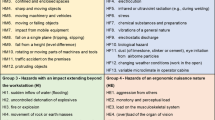Abstract
An environmental study for the appraisal of work hazards and safety in Jeddah Industrial Estate (JIE), Saudi Arabia has been conducted. The study is based upon a representative (stratified random) sample of 44 enterprises, including 52 plants and employing 5830 workers.
Nearly 2/3 of the workers have heat exposure, orginating from climatic heat and heat dissipated from industrial operations, while exposure to noise is slightly less, and is attributed to noisy operations and machinery and to lack of meticulous maintenance; both exposures are mild in most of the plants and moderate in some. Mild exposures to nonionizing radiations (UV and IR) and to deficient illumination occur in 25% and 19.2% of the plants studied. Respiratory exposure to chemical agents (organic and inorganic dusts, metal fumes, gases and vapours — including asphyxiants, irritants, liver and nervous system offenders and acid and alkali mists) occurs in 75% of the plants, particularly in the medium-size enterprises plants; however, is mainly mild with a few moderate and severe exposures. Skin absorption contributes to absorption of chemical agents in 29% of the plants, and direct skin contact to chemicals (particularly to lubricating oils) occurs in 81% of the plants.
Meanwhile, only eight plants, out of the 32 plants where controls for physical hazards are required (51.2%), apply engineering controls, and even in a few of these plants the efficiency of the control measures has been rated ‘bad’. A few of them provide personal protective equipment, and even no maintenance to this equipment is provided.
The level of safety is better in the large plants than in the small and medium-size plants; the safety score is the best in the recently established plants, while is the worst in the plastic industry, which is relatively old. The appraisal of fire protection is better than that of the safety, due to efficient supervision of the General Directorate of Civil Defense (GDCD). However, most of the safety problems are managerial and are preventable.
First aid is present in all enterprises, as required by the Saudi Labor Laws; however, an in-plant medical service is present in 75% of the large enterprises, in 31.6% of the medium-size and in only 17.6% of the small enterprises. Also, satisfactory medical, accidents and absenteeism records exist in only 15.9% of the enterprises; safety supervision exists in 27.3, and safety education exists in 91% of them, while no environmental monitoring is carried out in any enterprise. Sanitation facilities exist in satisfactory numbers in most of the enterprises; however, their maintenance is poor in most of them, due to lack of hygienic supervision. All enterprises dispose of their liquid wastes into the JIE sewerage system without any treatment, while the solid wastes are collected by the city authorities in 56.8% of them; both wastes are anticipated to cause environmental pollution problems.
Similar content being viewed by others
References
Noweir, M.H.: 1987,Occupational Health/Hygiene in Saudi Arabia, WHO Consultation Assignment Report, Project SAA/OCC/001., WHO/EMRO, 2 March–30 May.
Alidrisi, M.M.et al.: 1988,Environmental Stresses in Jeddah Industrial Area, A final report for the research agreement AR-7-87 with KACST, King Abdulaziz University, Jeddah.
Noweir, M.H., Alidrisi, M. and Aljiffry, M.: 1991, ‘Appraisal of Work Hazards and Safety in the Industrial Estate of Jeddah’, Final Report, Project No. 410/079, King Abdulaziz University, Jeddah, Saudi Arabia.
Noweir, M.H., Alidrisi, M. and Aljiffry, M.: 1991, ‘Profiles of Enterprises and Workforce in the Industrial Estate of Jeddah’,Al-TA'Awon Al Sinae Journal, Doha, Qatar. (In press)
NIOSH: 1977,National Occupational Hazard Survey, Volume 1, National Institute for Occupational Safety and Health, U.S.A., Publ. No. 77.213, pp. 1–142.
NIOSH: 1984,National Occupational Hazard Survey, Volume II, National Institute for Occupational Safety and Health, U.S.A., Publ. No. 77.127, pp. 1–87.
Noweir, M.H.: 1991,Study of Occupational Hazards in Small and Medium-Size Industries in Alexandria, A final report on the research agreement No. 3-P-86-008 of IDRC, Ottawa, Canada.
Singleton, W.T.: 1972,Introduction to Ergonomics, World Health Organization, Geneva, pp. 110–15.
Clayton, G.D. (Ed.): 1973,The Industrial Environment — Its Evaluation and Control, USDHEW-PHS-National Institute for Occupational Safety and Health (NIOSH), U.S.A., pp. 95–100, 711–12.
Noweir, M.H., Aljiffry, M.S. and Almoreb, A.A.: 1992, ‘Study of the Heat Stress in the Saudi Cables Plants in Jeddah’,J. Egypt. Publ. Hlth. Assoc. (In press)
Canadian Forces: 1968, Administrative Order 34–47, 15 November. Cited in Kuehn, A.L. and Kroon, C.J.: ‘Heat Stress in Industry’,J. Can. Ceramic Society 45 (1979), 59–62.
Vihma, T.: 1981, ‘Health Hazards and Stress Factors in Small Industry — Prevalence Study in the Province of Uusimea with Special Reference to the Type of Industry and the Occupational Title as Classification for the Description of Occupational Health Problems’,Scan. J. Work Environ. Health 7 (Suppl. 3), 9–149.
Vihma, T. and Numinen, M.: 1978, ‘A Study on Working Conditions in Small Industry’, Institute of Occupational Health, Helsinki, p. 172.
Tuskes, M.P.: 1988, ‘Potential Hazards in Small Business — A Gap in OSHA Protection’,App. Ind. Hyg. 3 (2), 55–57.
Cho, K.S. and Lee, T.J.: 1975, ‘Une Surveillance Plote en Medicine du Traveil; Probleme des Petites Industres en Core'e du Sud’,ACMS Cahiers de Medicine Inter. Professionelle 57 (1), 11–12.
U.S.P.H.S.: 1972,Occupational Health Survey of the Chicago Metropolitan Area, U.S. Department of Health, Education and Welfare, Public Health Services, Cincinnati, Ohio, p. 103.
Hiltanen, M., Kakko, K., Yijanheikki, E., Hassi, J. and Tolonen, M.: 1979, ‘Occupational Hygiene Survey of 99 Small Work Places with Special Reference to Occupational Health Services’,Scan. J. Work Environment. Health 5 (2), 30–40.
Vihama, T. and Nurminen, M.: 1983, ‘Illumination in Small Industry’,A.M. Ind. Hyg. Assoc. J. 44 (7), 501–4.
Ulfarson, U.: 1976, ‘Work Environment in Small Workplaces’, Stockholm, p. 109 (Abstract). Cited in Ref. 9.
Author information
Authors and Affiliations
Rights and permissions
About this article
Cite this article
Noweir, M.H., Alidrisi, M.M. & Al-Jiffry, M.S. Appraisal of work hazards and safety in the industrial estate of Jeddah. Environ Monit Assess 27, 35–68 (1993). https://doi.org/10.1007/BF02401764
Received:
Revised:
Issue Date:
DOI: https://doi.org/10.1007/BF02401764




